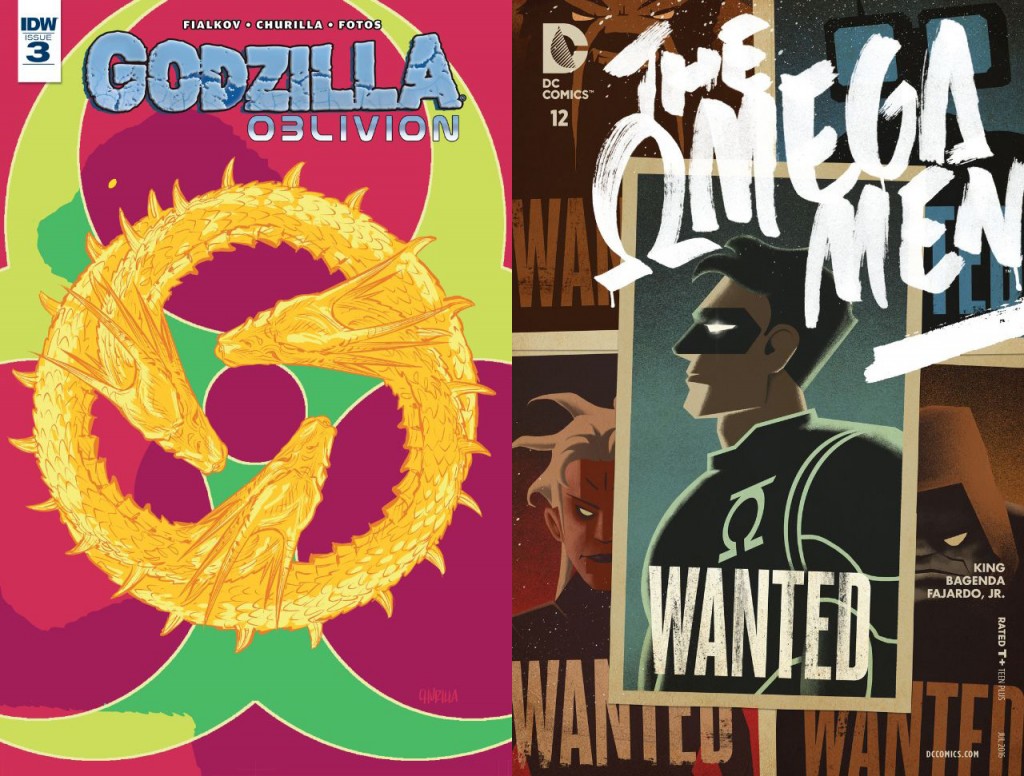Deadshirt Is Reading… is a weekly feature in which Deadshirt’s staff, contributing writers, and friends-of-the-site offer their thoughts on Big Two cape titles, creator-owned books, webcomics and more.
Patrick Stinson is reading…
Godzilla: Oblivion #3
Written by Joshua Fialkov
Art by Brian Churilla
Colored by Jay Fotos
Lettered by Chris Mowry (also a Creative Consultant)
IDW
“Deploying Mechagodzilla.”
“What did you just say?”
“Give me a break, Talbert. It sounded cool.”
Godzilla: Oblivion is Yet Another High Concept Godzilla Miniseries from IDW. Back in issue #1, some Science Dudes from a universe without kaiju (so…a normal one) traveled to a universe with kaiju, met some folks, and accidentally lured Godzilla’s archenemy King Ghidorah back into their own universe. So now both universes are trashed…sorta defeating the point of having two in the first place.
Which brings us to issue 3, a book so impossibly generic that I had to go back and remind myself what the premise of the miniseries was in the first place. In a typical “let them fight” play, Godzilla has been lured back to “Earth-1” to fight King Ghidorah. They fight. While they do this, two strawman characters argue with each other about whether scientific progress does or does not justify neglectfully ending the Earth. Godzilla and King Ghidorah get nuked. This makes Godzilla more powerful. But then it turns out there’s an army of Mechagodzillas! Each of the preceding six sentences has literally happened before in an IDW Godzilla book.
It’s clear that for whatever reason (probably having something to do with Toho Studios’ strict rules for using the characters), IDW Comics keeps returning to the same few stories in the metaphorical equivalent of the stock footage padding Godzilla movies ran in the ‘70s. Rebooting the timeline over and over with gimmick miniseries just makes it more obvious.
It’s time for IDW to look back at the Godzilla comics that worked—Marvel’s, Dark Horse’s, and their own Rulers of Earth timeline—and come up with a plan. Godzilla was never a perfect fit for the medium of comics—it’s almost too free and open-ended, with few artists and letterers able to convey the awesome scale and impact that attracts generation after generation to the kaiju film canon. To make a good Godzilla comic, you’ve got to pick something and stick with it, rather than just remixing a bunch of slightly different apocalypses.
Adam Pelta-Pauls is reading…
Omega Men #12
Written by Tom King
Art by Barnaby Bagenda
Colors by Romulo Fajardo, Jr.
Letters by Pat Brosseau
Covers by Trevor Hutchinson
DC
“I’ve been a Lantern for years, served with every race and species. Everyone is savage. Everyone is civilized. We’re all the same. In the end. I’m not afraid of becoming them, Viceroy. I’m proud to say, I already am them.”
Omega Men has been a real rarity among Big Two releases lately. Rarely, if ever, does a book so topical, so thoroughly of the right-fucking-now, come out of Marvel or DC. Indeed, not even DC itself believed how good it was, leading to its infamous cancellation and immediate un-cancellation, after a massive fan outcry. Tom King took a third-tier DC space hero team that hadn’t been seen since Adam Strange: Planet Heist and made them into the must-read book of the past year. Eschewing the “quirky reboot, á la Guardians of the Galaxy” model, King’s Omega Men starts with the public execution of a top-tier Green Lantern and continues into the story of a group of ISIS-like freedoms fighters for whom the reader is rooting.
You might notice that I included the cover artist for the series in the credits at the top. Trevor Hutchinson has done the covers for the entire series, and it’s his work there that helped make this book look so much unlike anything else on the shelves at your LCS. The covers are all defaced pro-Citadel propaganda posters, and they’re honestly pretty haunting. They give a little clue about the story inside each issue, and finding out what the slogans on them meant was usually a twist of the knife.
King’s work at the CIA clearly played a part in the creation of this comic. It begins with Kyle Rayner traveling to the forbidden Vega system, on a mission of diplomacy, but quickly evolves into a story about the dangers of getting involved in a foreign conflict without understanding it. Rayner serves as the reader’s surrogate, missing the nuances of the war, trying to take a strictly moral stance. It’s an untenable position, though by the time Rayner realizes this, it’s all too late.
Of course, it’s always too late for anyone in that position. And that’s what this book is about. It’s the kind of great sci-fi I wish politicians (for example) would read more of and understand. Yes, it’s a story that involves aliens of many different shapes and colors, but they all stand for something bigger. It’s a book about accepting the Other, or at least trying to see it their way. Because they’re human, too, and we all have a right to have things seen our way.
This issue ends the run, and it’s already one of my favorite series endings of all time. It’s succinct, not overly saccharine, and does a great job of being a comic book ending. King’s understanding of and empathy for these characters is also really evident here. He draws on one of the lesser-known pillars of Kyle Rayner’s backstory, his career as a comic book artist, to make a point at the very end, and it’s…really beautiful. Sometimes comic books have great runs but botch the landing. This is not one of those books.
Thanks for reading about what we’re reading! We’ll be back next week with a slew of suggestions from across the comics spectrum. In the meantime, what are you reading? Tell us in the comments section, on Twitter or on our Facebook Page!


